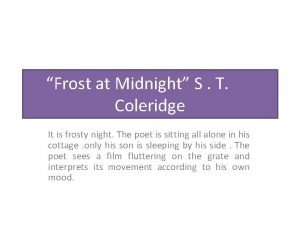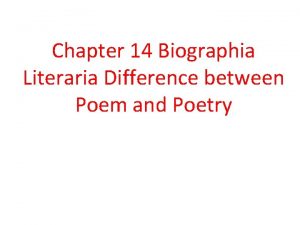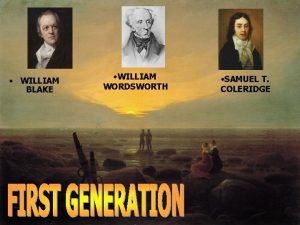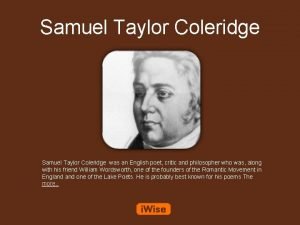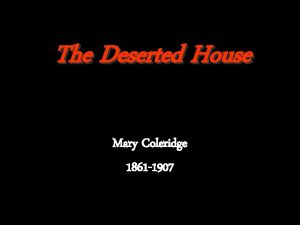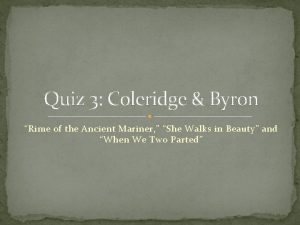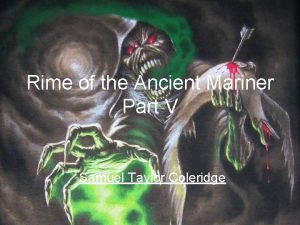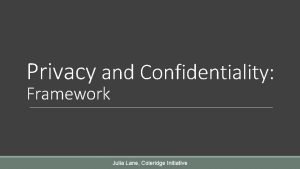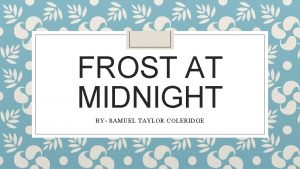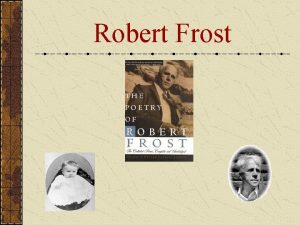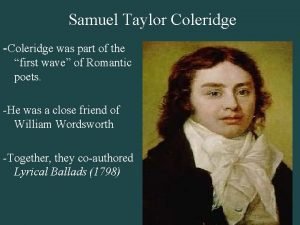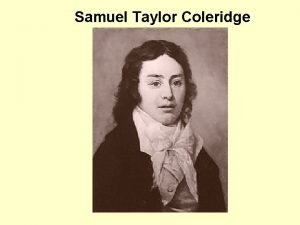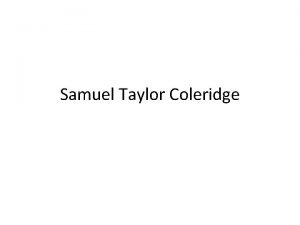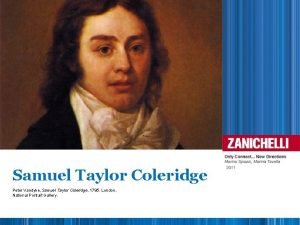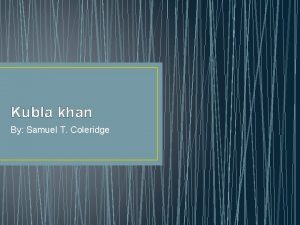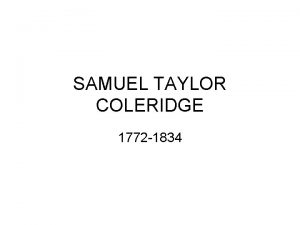Frost at Midnight S T Coleridge It is









- Slides: 9

“Frost at Midnight” S. T. Coleridge It is frosty night. The poet is sitting all alone in his cottage. only his son is sleeping by his side. The poet sees a film fluttering on the grate and interprets its movement according to his own mood.

Analysis • L 1 -7 The frost is being formed invisibly. All the inmates of the poet’s cottage are asleep. There is nobody to witness the frost being formed. Besides, there is no wind to help the formation of the frost. The owlet’s cry can be heard at intervals. The poet is sitting all alone. His loneliness is suitable to his abstract thinking. His little child is peacefully sleeping by his side.

Analysis • L 8 -10 There is perfect silence around him. In fact , it is so silent that he is disturbed in his thoughts. The poet has suggested a psychological idea that solitude is useful for meditation but too much solitude disturbs one’s deep thoughts and causes a feeling of loneliness and restlessness. • L 10 -13 There is perfect silence outside the poet’s cottage. The village inhabitants are all asleep. All their life activities have been suspended. They are now silent like dreams. • L 13 -14 The fire has burnt itself low. There is a thin blue flame on the fire but it is perfectly still. It does not even quiver , tremble or flicker. • •

Analysis • L 15 -16 The only wakeful thing is that film which was quivering on the grate and which is still quivering now. Apart from that film , everything is still and motionless. • L 17 -23 The poet thinks that the movements of the film create some sort of affinity between him and the film since they are the only wakeful things. His idle spirit interprets the film movements according to his own mood. The film then is a kind of a mirror in which the poet reflects his thoughts. He is at the moment playing with his thought as one plays with a toy.

Analysis • Note : this poem was written under the influence of Wordsworth. Coleridge then gives Nature an independent identity capable of comforting people. Later, he comes to believe that Nature does not have any life of its own and we interpret different natural phenomena according to our own mood. Coleridge hinted at this idea when he says that he interprets the puny flaps and freaks of the thin film according to his own mood.

Themes • Serenity of nature vs. agitation of the poet. • The poet’s relentless mood is out of tune with the universal hush of nature around him. He discovers that his solitude, to which he has been left is disquieting and produces an opposite effect in him( it is not a solace). Unable to communicate with the world, he looks about something to which he can relate and find( as he thinks) a companionable form in the film fluttering on the grate – the only unquiet thing. Thus, contrast is established between the silent working of nature and the busy processes of the poet’s mind.

Analysis • L 20 -40 This image of the fluttering film provides a bridge from actual to remembered experience. It goes back to seeing the same kind of film at school, where it was thought to herald the arrival of some friend. It makes him recall the vision of his ‘sweet birth place’ that had lingered with him during school hours and superstitiously prompted him to hope that the schoolroom door would open to reveal this glad past in the shape of a townsman, his aunt or his beloved sister Anne.

Analysis • L 40 -60 In this conversation poem, Coleridge’s cradled infant, Hartley, is the listener. The poet explores the contrast between his and his son’s projected education amid the beauties of the natural world. He is referring to the ‘natural’ education that his son will experience under the benevolent preceptorship of the ‘Great universal Teacher’ who reveals ‘Himself’ in all, and all things in ‘Himself. ’ This part of the poem shows the poet’s interest in nature, childhood and innocence.

Analysis • The last stanza…. . The poet is delighted that his son will have more opportunities to observe the beauty of nature and will not be “reared/ In the great city, pent ‘mid cloisters dim, ” as Coleridge was. He wishes that “all the seasons shall be sweet” to his son and that his son will learn to appreciate all aspects of nature. The ‘deep calm’ that had originally pressured the poet is no longer vexing. Sound and silence coexist symbolically , the water –drops heard falling from the eves( edges of the roof) or being hung in silent icicles, the blowing wind and the secret ministry of frost are all parts of one wondrous whole; they are now, as the poet listens with his heart as well as with his ears, the sound of one eternal language.
 Frost at midnight line by line explanation
Frost at midnight line by line explanation Difference between poetry and poem according to coleridge
Difference between poetry and poem according to coleridge William blake and samuel taylor coleridge
William blake and samuel taylor coleridge Samuel taylor coleridge what if you slept
Samuel taylor coleridge what if you slept The deserted house mary coleridge
The deserted house mary coleridge Samuel taylor coleridge the rime of the ancient mariner
Samuel taylor coleridge the rime of the ancient mariner Rime of the ancient mariner quiz
Rime of the ancient mariner quiz Samuel taylor coleridge biography
Samuel taylor coleridge biography Why is confidentiality important
Why is confidentiality important Midnight thirst
Midnight thirst
